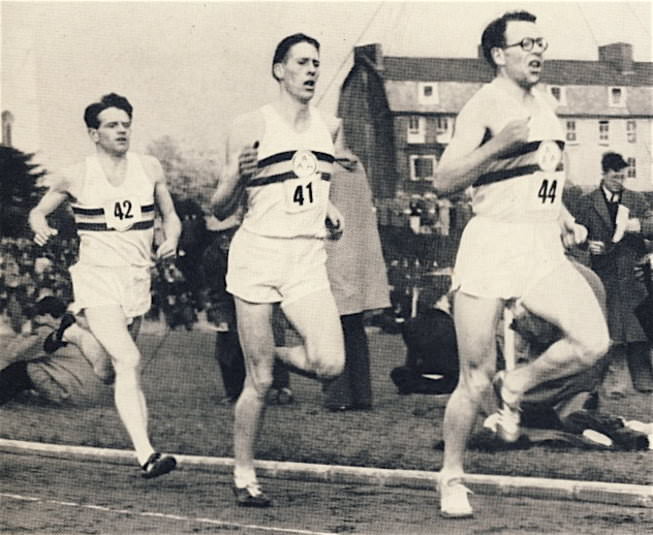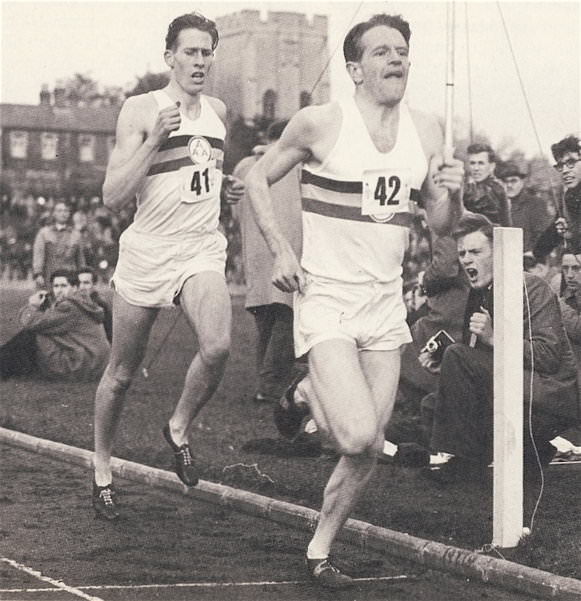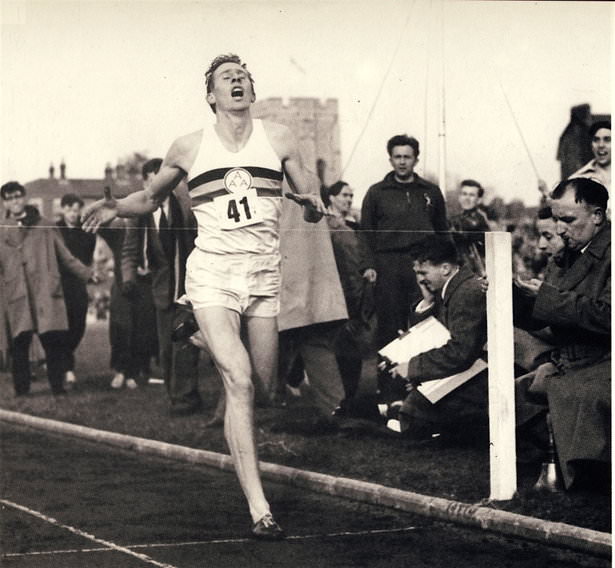Bannister's 3:59.4
First Four-Minute Mile, Oxford, UK, May 1954
Great Races #8
The black-and white photo of Roger Bannister crossing the finish line in Oxford on May 6, 1954, is one of the most famous in the history of running. Head back, eyes closed and mouth agape, with transfixed spectators and an overwhelmed official in the background, Bannister is caught a fraction of a second before he breasts the tape just less than four minutes after the starter’s gun had fired. This was the moment that man first broke four minutes for the Mile. It was a symmetrical barrier: four laps of a quarter-mile track to be run in less than one minute per lap. Several athletes had come close over the previous dozen years. Yet there was something about the symmetry of the four-minute mile that made is seem impossible. This impossibility had surely affected Hagg and Andersson in the 1940s. And the same psychological effect was felt by the leading milers in the 50s when John Landy, Wes Santee and Roger Bannister were all “racing” towards the first sub-4. The story of these three great runners’ attempts to be the first is finely recounted by Neal Bascomb in his book The Perfect Mile.
 |
| Brasher ignores Bannister's shouts of"Faster!" and reaches 880 in 1:58. |
Bannister’s approach was a combination of intellect and emotion. He was very highly strung and very intelligent. A great deal of planning had gone into his successful attempt at breaking the barrier. Much of this planning he had done on his own, but in the latter stages he had been assisted by Franz Stampfl, who was probably the most intellectual coach around. With his sometime training companions Chris Chataway and Chris Brasher, he planned to achieve his goal at Oxford in a match between the university and the AAA. This race was ideal because there would be only six athletes in the race; the small field would give the trio the space to orchestrate the race according to their needs. The Iffley Road cinder track was a good one; the only other ingredient was the weather, which was the one thing over which they had no control.
As it happened the weather was a problem. On arriving at the track, Bannister found the wind was “almost gale force.” Bannister wrote in his book: “I had reached my peak physically and psychologically. There would never be another day like it …. This was my first race for eight months and all this time I had been storing nervous energy. If I tried and failed, I should be dejected, and my chances would be less on any later attempt.” (First Four Minutes, pp.187-8) Even as they warmed up, the wind was still gusting. It wasn’t until he was on the starting line that he saw the St George’s flag on a nearby church go limp and decided to go for it.
 |
| Chataway takes Bannister into the bell lap at 3:00.7. |
The race did not start well as Brasher made a false start. After receiving a warning, Brasher headed the field round the first bend with Bannister on his heels. “I slipped in effortlessly behind him, feeling tremendously full of running. My legs seemed to meet no resistance at all, as if propelled by some unknown force.” (FFM, p.191) Bannister had rested an amazing five days before this, so it is not surprising that he felt so full of running. Still, this good feeling could have ruined his chances as he wrongly sensed that Brasher was going too slowly. Fortunately Brasher ignored Bannister’s shouts of “Faster!” The first lap was fast enough at 57.5. Bannister was still worrying at 660 that the pace was too slow, but Brasher’s halfway pace was perfect: 1:58. Chataway took over on the first bend of lap three and led Bannister through three laps in 3:00.7. The pacing couldn’t have been better.
Chataway maintained his lead round the first bend; then Bannister took off: “I had a moment of mixed joy and anguish, when my mind took over. It raced well ahead of my body and drew my body compellingly forward. The moment of a lifetime had come. There was no pain, only a great unity of movement and aim. The world seemed to stand still.” (FFM, pp.191-2) Bannister’s book describes poetically how he covered those last 300 yards and “leapt at the tape like a man taking his last spring to save himself from the chasm that threatens to engulf him.” (FFM, p.192)
 |
| Bannister's moment of glory: 3:59.4. |
He knew he had beaten 4:00 before the time was even announced. On the announcement of the time, 3:59.4, the trio took a lap of honour. History had been made. The pacing by Brasher and Chataway had been perfect. But some felt that this achievement was tainted by the blatant pacing. The attitude at this time was that world records should be achieved through pure racing; Brasher, Chataway and Bannister had acted within the letters of the current amateur rules but not within the spirit of those rules. Some, especially the Australians, have argued that Landy’s 3:58 in Turku was the first legitimate sub-4 as it was achieved in a genuine race, not in what was, in many respects, a time-trial. Len Johnson in The Landy Era discusses this issue thoroughly (pp. 197-199).
The next day, Brasher, Chataway and Bannister went for a walk on Harrow Hill, where Bannister had done a lot of his training. Brasher has described the feelings on that day: “There was in that hour or two a closeness, man to man, such as I had never experienced before or since. We had trained together and fought together. We had been rivals and one man had proved himself incomparably the best. Yet there was no resentment - just a sweet relish of the past, a companionship of the moment and resolutions, idealistic all of them, for the future.” (Mexico 1968, A Diary of the XIXth Olympiad)
Result: 1. Roger Bannister 3:59.4; 2. Chris Chataway. 4:07.2; 3. W. T. Hulatt 4:16. 
|
Films Four Minutes, Jamie MacLachlan, Christopher Plummer. The Four-Minute Mile, Richard Huw, Michael York. |
1 Comment